Income has to lift for RBA rate rise: RBA's Philip Lowe
RBA Governor Philip Lowe's address to the Australia-Israel Chamber of Commerce in WA
I would like to thank the Australia-Israel Chamber of Commerce for the invitation to speak at this lunch today. It is great to be back in Perth again. I look forward to learning more about how the Western Australian economy is going. Later this year, the full Reserve Bank Board will be here for our monetary policy meeting on the first Tuesday in September.
When I was in Perth six months ago I gave a speech titled ‘The Next Chapter’. In that speech I explored some of the likely plot lines in the next chapter of Australia's economic history. I would like to continue that broad theme today.
For most of the past decade, a common shorthand description of the Australian economy was that it was a ‘two-speed’ economy. For some time, Western Australia and Queensland were growing very quickly on the back of investment in the resources sector, but growth in the other states was subdued. And then things turned around: growth was weak in Western Australia and Queensland, and stronger elsewhere. So it's understandable that people have talked about a ‘two-speed’ economy.
In a country as large and diverse as Australia, it is not surprising that we experience differences like this from time to time. It is important that the Reserve Bank understands these differences and, indeed, we devote considerable resources to doing this.
But today, rather than focus only on the differences across regions, I also want to focus on the similarities.
I would like to do this from two perspectives. The first is from a cyclical perspective and the second is from a structural perspective. From the cyclical perspective, the good news is that conditions have improved across most of Australia over the past year. And from a structural perspective, over time the differences in the structure of output and employment across regions are tending to become smaller, rather than larger. So I would like to talk about this. There are, of course, still important differences across the country and I will discuss some of these as well. Finally, I will finish with some comments about the recent monetary policy decisions of the Reserve Bank Board.
The Cyclical Perspective
Over the past year, when discussing the national economy, the Reserve Bank has focused on a number of themes. I would like to highlight four of these again today (Graph 1).
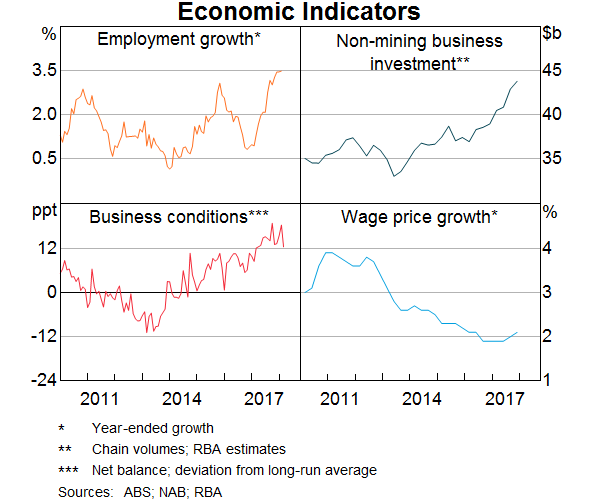
The first is the strong growth in employment. Over the past year, the number of Australians with jobs has increased by 3½ per cent, which is a very positive outcome. Labour force participation has also increased, especially by women. The unemployment rate has also fallen over the past year, although it has been steady at around 5½ per cent over the past six months.
The second theme is a pick-up in non-mining business investment. We had been waiting a long time for this to occur, but in 2017 the long-forecast lift in investment finally took place. Over the year, non-mining business investment increased by 12½ per cent, the largest rise in a decade, and a further increase is expected.
The third theme is an improvement in business conditions, as reported in surveys. These surveys are currently more positive than they have been at any time since the financial crisis. They also suggest that capacity utilisation has been increasing.
The fourth theme has been slow growth in wages. Wage increases around 2 per cent have become the norm in many parts of the country. This is in contrast to the 3 to 4 per cent increases that were the norm for most of the past two decades. This change is having a sobering effect on the finances of many households. It is also contributing to inflation being low. The latest data suggest that the rate of wages growth has now troughed, with a pick-up evident in the most recent quarter. A further lift is expected, but it is likely to be only gradual.
So the overall picture for the national economy is one of gradual improvement: businesses are feeling better than they have for some time and they have increased their investment and hiring. It is therefore reasonable to expect that economic growth in 2018 will be stronger than the 2.4 per cent outcome we saw last year.
This improvement in the economic climate has occurred across the country, not just in one or two areas. There are, of course, regional differences, but these four themes are evident across the country, although to varying degrees.
Over the past year, employment has risen in all states (Graph 2). This is a different picture than we've seen for some time. Here in Western Australia, there was virtually no employment growth for more than four years after the peak in mining investment. Over this period, Western Australia went from having an unemployment rate of two point something to six point something. Recently, though, the labour market here has begun to improve, with employment increasing by 2½ per cent over the past year and the unemployment rate having come off its peak. There has been strong growth in jobs in education and health, as there has been around the country.
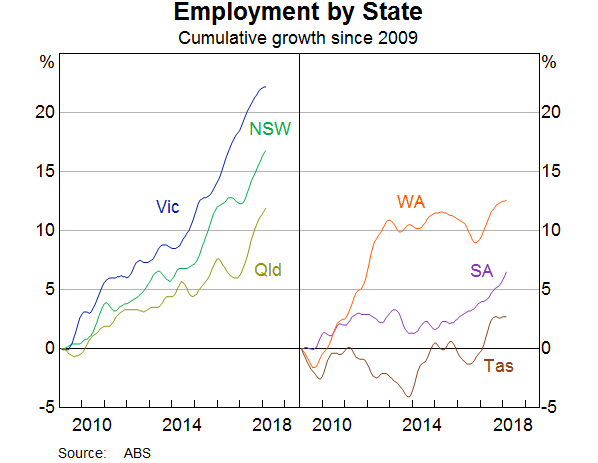
Turning to non-mining investment, the state-level data are less timely. We do know, however, that in most states total business investment picked up through 2017, with particularly strong growth in non-residential construction (Graph 3). Here in Western Australia, the picture is a little different, given the ongoing unwinding of the mining investment boom. Over the past year, total business investment in Western Australia has been broadly steady, after earlier sharp declines. There has, however, been a pick-up in non-residential building approvals, which suggests that a turning point in non-mining business investment has now been reached. One area, though, that does remain weak is investment in dwellings, with the level of activity here in the west standing in contrast to the high level of dwelling investment in the eastern states.
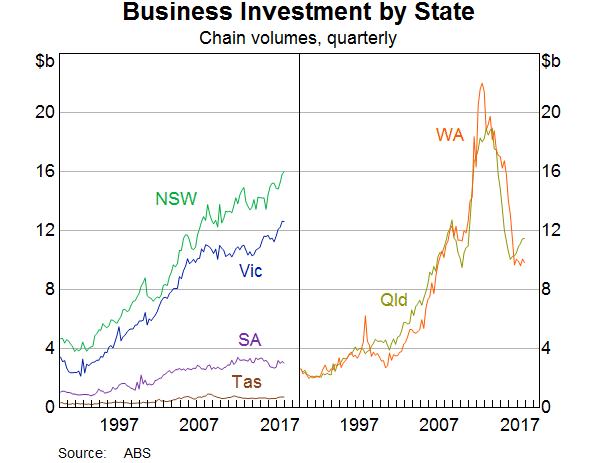
The third theme – the pick-up in survey-based measures of business conditions – is also evident across the country. For sake of simplicity, this next graph shows business conditions for Western Australia only and the rest of Australia (Graph 4). The direction of change is the same, even if conditions here are not as bright as elsewhere. In all states, including in Western Australia, reported business conditions are now currently above their long-term averages.
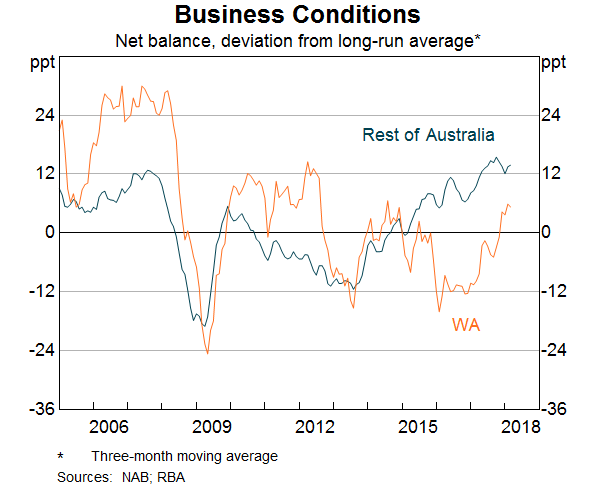
The final of the four themes is weak wages growth. This, too, is a national story. Over the past year, the wage price index increased by around 2 per cent or less in all states (Graph 5). For a number of years, growth in wages in Western Australia was running considerably above that in the rest of the country, with the result that the average level of wages here rose noticeably above that in other states. In the past couple of years, this differential has narrowed, with growth in wages here below the national average. It is also worth pointing out that the most recent data show slightly stronger growth in wages in all states. This is a positive development.
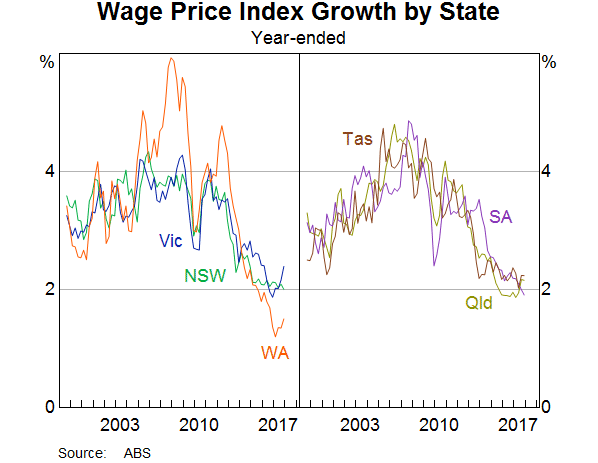
So the cyclical themes that we are seeing at the national level are playing out right across the country, although to differing degrees. We are now all moving in the same direction.
The Structural Perspective
I would now like to turn to the structural perspective. The main point is that, abstracting from the cyclical dynamics, there is a longer-run trend towards more similarity, rather than more divergence, in the underlying economic structure across the country.
An important area where this can be seen is the labour market. Over time, there has been a marked reduction in the dispersion of unemployment rates across the country (Graph 6). In particular, the standard deviation of the unemployment rate across the 87 individual regions for which the Australian Bureau of Statistics (ABS) publishes data is markedly lower than it was at the turn of the century.
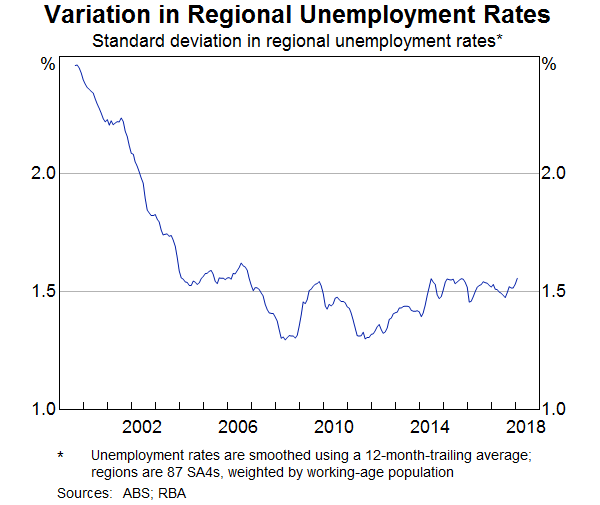
It is also worth noting that the average unemployment rate outside the capital cities is lower than the average unemployment rate in the capital cities for the first time in a long while (Graph 7). The gap between the participation rates for prime-aged workers in the capital cities and outside the capitals has also narrowed. So there has been a convergence of sorts.
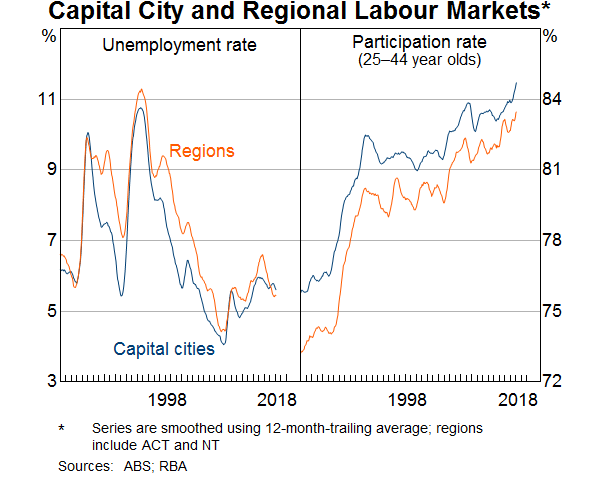
There are a number of possible explanations for this. One is that the labour market has become more flexible, including through the movement of people. Another is that the economic shocks experienced have become less region specific.
It is hard to be definitive, but both explanations are likely to have played some role.[1]
The improved flexibility of the Australian labour market is no doubt part of the story, and the willingness of people to move for jobs is part of this. However, the propensity of people to move interstate, or within their state, has declined over the period that the dispersion in unemployment rates has declined (Graph 8). For the two decades to the mid 2000s, around 2 per cent of us moved states each year. Over recent times that share has fallen to 1½ per cent.
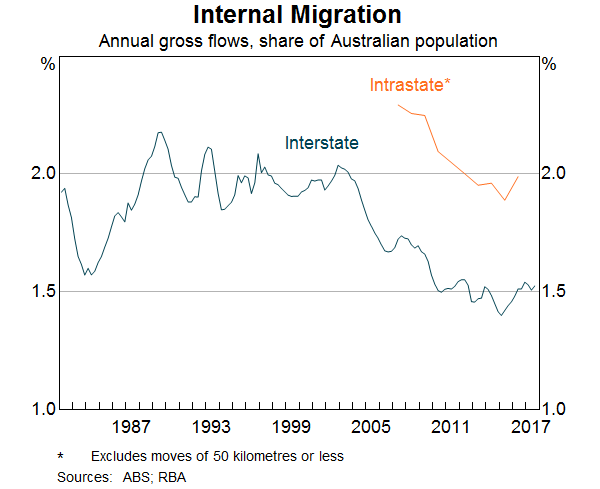
Another important part of the story is overseas migration. This is evident in this next graph, which shows the contribution to employment growth from interstate migration, overseas migration and people already living within the state (Graph 9).[2] The role that overseas migration played in the adjustment process here in Western Australia is clear. When the boom was in full swing the workforce in Western Australia was boosted significantly by workers from overseas. And then after the boom, the flow of immigrants slowed considerably. It is also clear that, over recent years, more people have been moving from Western Australia to other states than vice versa. This is in stark contrast to the boom years. The overall conclusion here is that the movement of people has helped even things out across the economy.
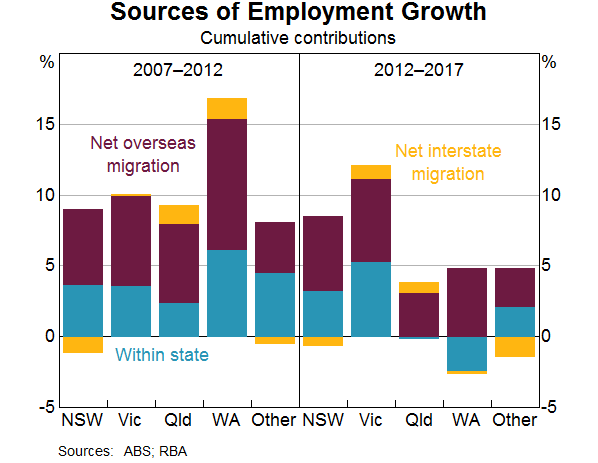
The other possible explanation for the reduced dispersion in unemployment rates is that many of the economic shocks we experience nowadays are less regionally concentrated – with the mining investment boom being an obvious exception! – perhaps because of less variation in the structure of regional economies.
It is difficult to test this idea rigorously, especially the nature of the shocks. But we can look at the variation across the country in the industries in which people work and the type of jobs they have. My colleagues at the RBA have done this using Census data for the more than 300 separate geographical areas in Australia.[3] Using these data, they have constructed indices of how different the various regions are in terms of the industries that people work in and the occupations that they have. I will spare you the technical details of these calculations.[4] My colleagues have also calculated how these indices have moved through time and they have conducted the exercise both including and excluding the regions with a heavy concentration in mining. The results are shown in this next graph (Graph 10).
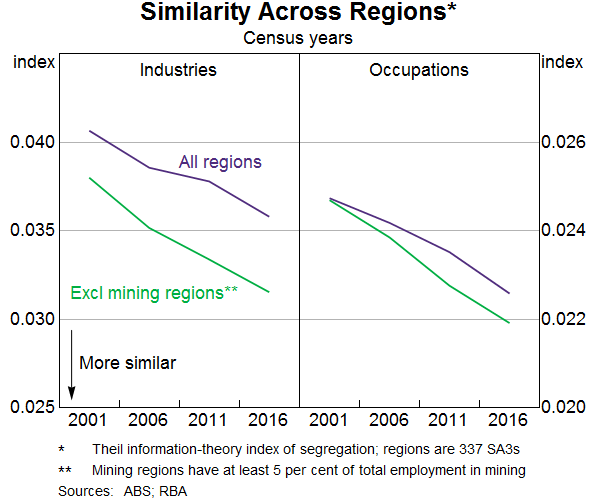
The main conclusion from this work is that, on average, regions are becoming more similar. Over time, the industries we are working in, and our occupations, are becoming more alike across Australia, not more different. There are, of course, still large differences across regions, but they are smaller than they once were.
One important reason for this is the increasing relative importance of service industries, and the decline in the relative importance of manufacturing. Both of these are national phenomena. Using the data from the 300-plus individual regions, it is clear that the variation across the country in the share of the workforce employed in the manufacturing industry has declined since the early 2000s (Graph 11). In 2016, the distribution is more tightly clustered around a lower average than it was in 2001. It is also clear from the Census data that those regions that had a relatively high share of workers employed in manufacturing in 2001 have tended to have faster growth in services employment than have other regions. So we are becoming more alike.
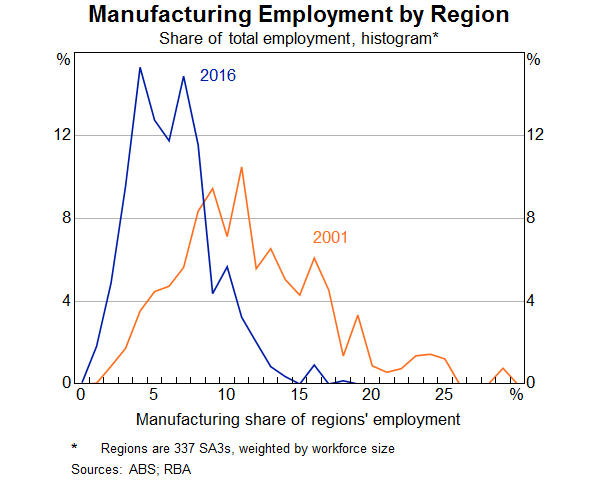
None of this is to say that there are not big differences across our country. There clearly are, and I will come to some of these in a moment. But, on average, the growth of the services industries has meant that the differences in industrial structures across regions have narrowed over time. I would expect that this would continue.
As I have spoken about on previous occasions, the growth of services and increasing investment in technology mean that investment in human capital is critically important to the country's future success. This needs to be a national focus. We are making progress, but there is more to be done, with investment in human capital central to building comparative advantage. This next graph shows the distribution across regions in the share of the population with an advanced qualification, defined here as a Certificate III or higher (Graph 12). There has been a marked shift to the right in the distribution. By 2016, there were only a few regions in which less than half of all 25–44 year olds held an advanced qualification. This is a noticeable change from the early 2000s and suggests the lift in qualifications is broadly based across regions. If anything, the dispersion across regions has also lessened over time.
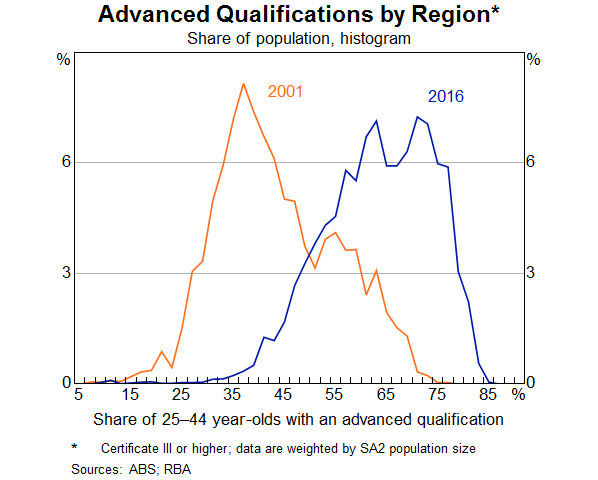
So far I have spoken about the commonalities in the cyclical and structural stories. It is important, though, to recognise that there are significant differences across regions. One illustration of this is the different average level of wage income across the country, which we can calculate from individual tax returns (Graph 13). There is considerable variation across the country, with some regions having average wage income more than 50 per cent above the national average. Wage income also tends to be higher in the capital cities than elsewhere. In part, this is explained by the types of jobs available in larger cities. For example, the capital cities are home to over 80 per cent of all IT, business, HR and marketing professionals, while only around 65 per cent of people live in these cities. On average, these business-service roles attract higher wages than many other occupations.
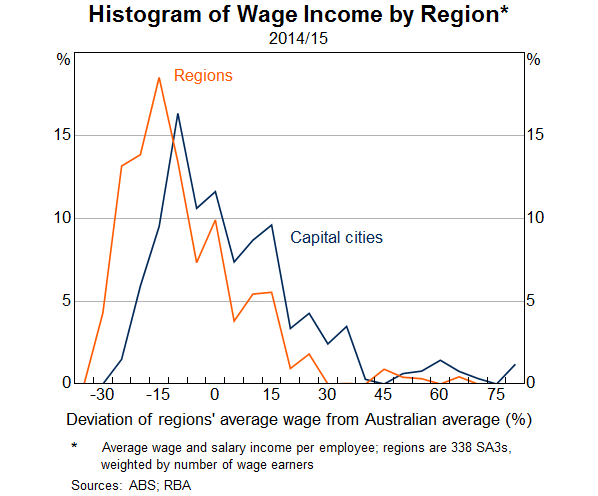
Another notable difference across regions is the level of housing prices. This reflects not just differences in average incomes, but the underlying demand and supply dynamics. This next graph shows the standard deviation in housing prices across the country, using data for around 330 separate regions (Graph 14). The picture is pretty clear: the dispersion in housing prices is currently larger than it has been in a very long time. This mostly reflects the big run-up in housing prices in Sydney and Melbourne at a time when price growth in the rest of the country has been subdued.
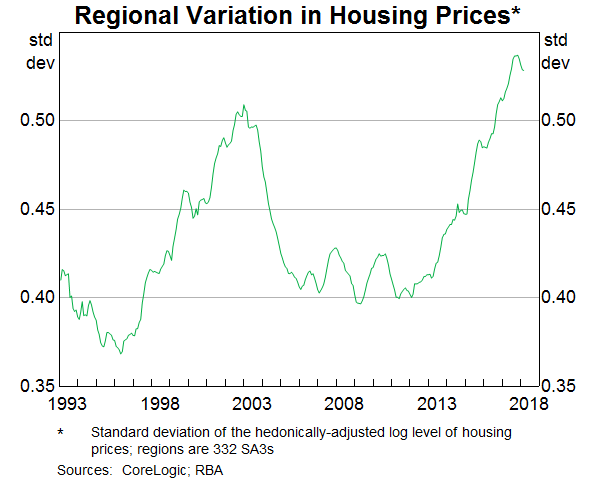
It's clear from this graph that, in the past, this measure of variation has had a cyclical element: it increases for a while and then declines. It is understandable why this happens. When prices increase a lot in one area, relative to another, some people relocate to where prices are lower, especially if jobs are available. This certainly happened in the late 1990s/early 2000s, when there was a marked pick-up in people moving from New South Wales to Queensland following the big increase in housing prices in Sydney. It's too early to tell whether the same type of adjustment will happen this time, but the number of people moving from New South Wales, where housing prices are highest, to Queensland (and, to a lesser extent, Victoria) has begun to pick up.
Monetary Policy
I would now like to turn to monetary policy.
The Reserve Bank's responsibility is to set monetary policy for Australia as a whole. We seek to do that in a way that keeps the national economy on an even keel, and inflation low and stable. No matter where one lives in Australia, we all benefit from this stability and from being part of a national economy. This is so, even if, at times, in some areas, people might wish for a different level of interest rates from that appropriate for the national economy. In setting that national rate, I can assure you we pay close attention to what is happening right across the country.
As you are aware, the Reserve Bank Board has held the cash rate steady at 1½ per cent since August 2016. This has helped support the underlying improvement in the economy that I spoke about earlier.
In thinking about the future, there are four broad points that I would like to make.
The first is that we expect a further pick-up in the Australian economy. Increased investment and hiring, as well as a lift in exports, should see stronger GDP growth this year and next. The better labour market should lead to a pick-up in wages growth. Inflation is also expected to gradually pick up. So, we are making progress.
There are, though, some uncertainties around this outlook, with the main ones lying in the international arena. A serious escalation of trade tensions would put the health of the global economy at risk and damage the Australian economy. We also have a lot riding on the Chinese authorities successfully managing the build-up of risk in their financial system. Domestically, the high level of household debt remains a source of vulnerability, although the risks in this area are no longer building, following the strengthening of lending standards.
The second point is that it is more likely that the next move in the cash rate will be up, not down, reflecting the improvement in the economy. The last increase in the cash rate was more than seven years ago, so an increase will come as a shock to some people. But it is worth remembering that the most likely scenario in which interest rates are increasing is one in which the economy is strengthening and income growth is also picking up.
The third point is that the further progress in lowering unemployment and having inflation return to the midpoint of the target zone is expected to be only gradual. It is still some time before we are likely to be at conventional estimates of full employment. And, given the structural forces also at work, we expect the pick-up in wages growth and inflation to be only gradual.
The fourth and final point is that, because the progress is expected to be only gradual, the Reserve Bank Board does not see a strong case for a near-term adjustment in monetary policy. While some other central banks are raising their policy rates, we need to keep in mind that their economic circumstances are different and that they have had lower policy rates than us over the past decade, in some cases at zero or even below. A continuation of the current stance of monetary policy in Australia will help our economy adjust and should see further progress in reducing unemployment and having inflation return to target.
Thank you very much for listening. I look forward to your questions.
Click here to see the original speech.
